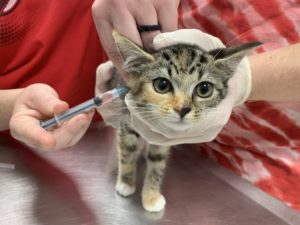By Dr. Beth Leermakers
What vaccinations does your cat need? The answer isn’t as straightforward for cats as it is for dogs (covered in my last column; Vol. 11, No. 30). There is considerable controversy in the veterinary community regarding whether cats need certain vaccinations and what adverse effects they cause. Fortunately, there are scientific guidelines regarding feline vaccinations.

Photo courtesy of Forsyth Humane Society
The Feline Vaccination Advisory Panel (FVAP), comprised of feline veterinarians and scientists, regularly evaluates and researches cat vaccination developments to make science-based recommendations. Their guidelines, published by the American Association of Feline Practitioners, are among the most trusted and utilized recommendations in the field. The FVAP divides cat vaccines into two categories: core (required for all cats, regardless of where they live and under what conditions) and noncore (recommended for some cats in some situations).
Core Vaccines
These four diseases are highly infectious and found worldwide. They are highly dangerous to young cats, and the vaccines are considered highly protective with minimal risk. Therefore, all cats should receive these four core vaccines.
Rabies. Although cats aren’t natural carriers of rabies, they can become infected by a bite from any infected mammal and spread the disease to other animals or people. After an incubation period of about two months, aggression, disorientation and death rapidly progress. Texas law requires all cats to be vaccinated against rabies by four months of age.
FVRCP Vaccine. The other three core vaccines are combined into one three-in-one vaccine (FVRCP), so your veterinarian can administer them all at once with just one injection. Your kitten should get her first vaccination at 6-8 weeks of age, and then again every 3-4 weeks until 16-20 weeks (for a total of three vaccinations). An older cat with an unknown vaccination history needs two FVRCPs, separated by 3-4 weeks. This initial series should be followed by a booster shot one year later. Indoor/outdoor cats should be vaccinated every year thereafter. Indoor-only cats should be vaccinated every three years thereafter. Cats heading into stressful situations, such as boarding, may benefit from a core vaccine booster 7-10 days before.
The three components of this vaccine protect your cat against:
FPV Vaccine. Feline panleukopenia, aka feline parvovirus, is a highly contagious disease that is often fatal to kittens. The disease usually starts with low energy and loss of appetite, then progresses to vomiting and diarrhea. Because the virus kills off white blood cells, infected cats are susceptible to secondary infections.
FHV-1 Vaccine. Feline herpesvirus causes severe signs of upper respiratory infection, including sneezing, nasal congestion and discharge, and conjunctivitis. This virus can also cause oral ulceration and pneumonia.
FCV Vaccine. Feline calicivirus also causes signs of upper respiratory infection, including sneezing and nasal discharge as well as oral ulcerations. FCV may cause chronic gingivitis/stomatitis, a very painful inflammation of the gums and teeth. In severe cases, FCV may result in hepatitis.
Non-Core Vaccines
These vaccines may be appropriate for some cats:
FeLV Vaccine. This vaccine protects your cat against feline leukemia virus. Transmitted through body fluids (saliva, urine and feces), FeLV is spread when an infected cat comes into contact with another cat — when they groom each other or share bowls. FeLV infection isn’t always fatal. Many cats go into a regressive state and appear healthy throughout their lives, but others don’t. The disease can progress to lymphoma, anemia or immunosuppression leading to secondary infection.
The FeLV vaccine is recommended as a core vaccine for kittens, with two doses given three to four weeks apart, starting at 6-8 weeks, followed by revaccination one year later for all pet cats. Subsequent vaccination for FeLV can be based on your cat’s risk for developing the disease: yearly for high-risk cats, every two years for lower-risk cats. Your veterinarian can help you assess your cat’s risk and determine an appropriate vaccination frequency.
Chlamydophila felis. This bacteria causes conjunctivitis but has also been associated with upper respiratory tract disease (URD). If you have multiple cats, and one cat develops an infection, your other cats may be vaccinated to protect them.
Bordetella bronchiseptica. Bordetellosis (“kennel cough”) is a contagious bacterial disease that primarily causes upper respiratory tract abnormalities. Easily spread in kennels, bordetellosis is most severe in young kittens (less than six weeks old) and in kittens living in less than ideal hygienic conditions. However, any cat with a pre-existing airway disease (e.g., feline herpesvirus and calicivirus infections) is susceptible to Bordetellosis, no matter how old it is. The best way to prevent this infection is to vaccinate your cat.
If you haven’t already done so, please visit your vet and determine what vaccinations your cat needs — based on her age, medical and vaccination history, and how likely she is to be exposed to a virus — and how often. You owe it to your cat to protect her health.
